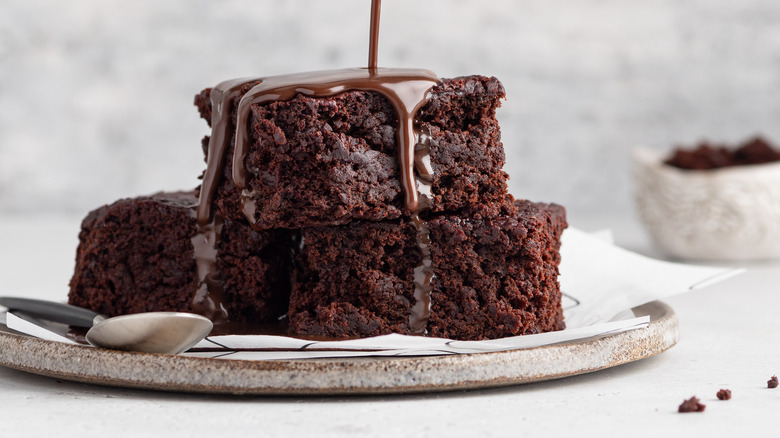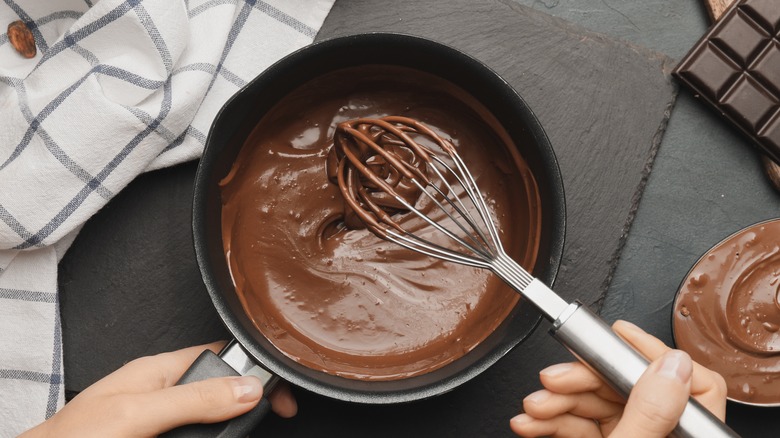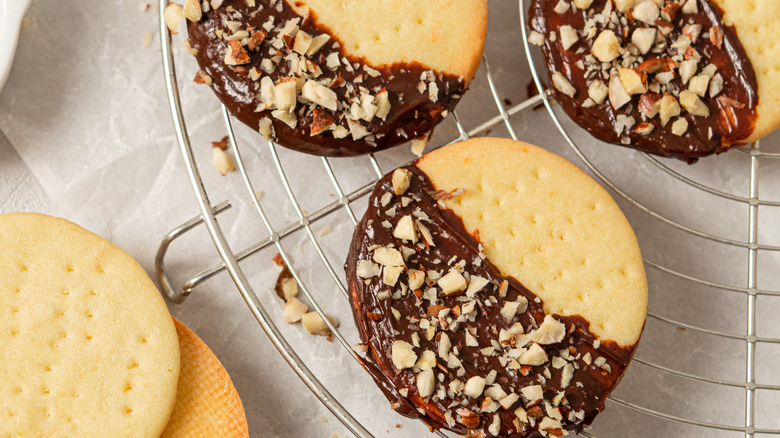The Only Ingredient You Need To Thin Out Melted Chocolate
There are few things more simply and deliciously better than melted chocolate. Decadent when drizzled atop dark chocolate soufflé à la mode, and great for dipping fresh, seasonal strawberries, blackberries, or cherries, melted chocolate is both versatile and extremely satisfying.
But, what happens when your chocolate is too thick, or separates into lumpy clumps after you've melted chocolate chips or baking chunks over a double-boiler or in the microwave? When this occurs, melted chocolate can be pretty much impossible to work with, and it loses its desired glossy sheen. While this challenge is frustrating, it is also very common (even a sort of right-of-entry for every great baker).
Luckily, overcoming this thickened chocolate obstacle (dare we say, mess) is simple. To thin out melted chocolate, you just need to add a small amount of oil. This chocolate-rescuing trick involves using a neutral, tasteless oil or fat in small increments, whisking it in until your chocolate is smooth and delectably drip-able. And not much fat is needed — ½ to 1 teaspoon of oil will often bring melted chocolate back to a workable consistency.
How to melt and thin out chocolate
Transforming your favorite chocolate — dark chocolate chips, semi-sweet chunks, or ready-to-melt baking disks — to a pour-able viscosity is best done in a glass bowl or double-boiler over indirect heat via steam, or in the microwave by heating and stirring at 30-second intervals.
Some bakers like to add in a neutral oil like canola or refined coconut as they melt their chocolate, though chocolate can be melted without first adding oil to the mix. Once melted, if you find your chocolate is too thick, simply whisk in an oil that has minimal taste in ½ teaspoon increments, until your chocolate reaches the desired consistency and becomes shiny and smooth.
While most vegetable oils you have in the pantry will work well, adding in grated or melted cocoa butter (the fat source extracted from cocoa nibs) is a great way to accentuate your melted chocolate's taste and melt-in-your-mouth nature. In that same vein, if you opt for vegetable oil, be careful not to add in too much, as it can create a waxy mouthfeel. Avoid adding in butter or reduced-fat milk to thin out your chocolate, since those ingredients contain water, which could separate the solids in your chocolate.
Once you've added in oil to thin out your chocolate, you can simply whisk until incorporated, or put the mix in the microwave to introduce some heat to help it combine. Either way, be gentle and careful not to over-mix or overheat.
Consistency is key for melted chocolate treats
Once you know the simple trick to thin out melted chocolate with a bit of fat, the opportunities for working with chocolate are endless. Think: drip cakes, chocolate-dipped homemade shortbread cookies, and chocolate sauces (and maybe even fancy chocolate designs or moulds for the brave of heart).
The key to refining the art of working with chocolate is knowing the right consistency for different applications. Typically a chocolate ganache — like one made to top chocolate hazelnut heart cakes with blackberry cream – comes together with melted chocolate and heavy cream and will be a bit thicker and richer than chocolate melted on its own. Whereas, for dipping strawberries you'll want a thin enough consistency to submerge and evenly enrobe, avoiding adding cream, so it forms a shiny, crisp shell coating.
Chocolate sauces and fudges for drizzling over ice cream, cakes, or brownies, have a consistency that is more open to personal preference. Depending on the application (or your cravings that day), you might want a runny chocolate sauce that is similar to the stuff Hershey's sells in bottles. To go for a more fudgy style, you may want a thicker sauce. Experiment with textures, and also ingredients — adding a bit of sea salt for a truly savory, sweet rich treat. Whatever your style, know that you can always add a bit of neutral oil to thin out your melted chocolate to the exact right consistency.


